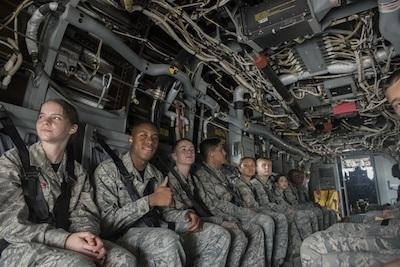Select Candidates Will Earn Private Pilot Certificates Beginning This Summer
Headquarters Air Force Junior ROTC has launched a program aimed at potentially putting more pilots in the cockpits of military aircraft to help address the Air Force’s ongoing aircrew shortage.

Beginning in the summer of 2018, select AFJROTC cadets who applied for a new Fight Academy scholarship will attend an accredited aviation program at one of six partnering universities to get a private pilot license.
The competitive application process started in fall 2017. The names of the initial 120 scholarship recipients from the more than 800 who applied will be released in early 2018.
“The number of applicants and the demographics of the applicant pool have turned out to be beyond any we could have hoped for. It is exciting to know we can concurrently answer the number and demographic issues of the aircrew crisis,” said Todd Taylor, AFJROTC Region 1 director and Flight Academy program acting director.
AFJROTC’s Flight Academy supports the Air Force Aircrew Crisis Task Force. The task force was tasked by the Air Force chief of staff to come up with new and innovative ways to address the service’s shortage of experienced aircrews. The ACTF is tackling the problem along seven lines of effort: requirements, accessions, production, absorption, retention, sortie production and industry collaboration.
The AFJROTC Flight Academy scholarship program is an initiative born of a joint military-industry working group within the industry collaboration line of effort that is responsible for “increasing intake.” The working group is charged with leveraging Civil Air Patrol, AFJROTC and general civil aviation to bring back the “luster of aviation” to high school students and to increase diversity in aviation fields.
“The Flight Academy initiative accomplishes two important tasks simultaneously: it helps ‘get the word out’ regarding the opportunities in the aviation community and it addresses the issue of diversity throughout the aviation community,” said Scotty Lewis, AFJROTC deputy director and the Increasing Intake Working Group military lead.
Of AFJROTC’s approximately 120,000 cadets, 58 percent are minority and 40 percent are female. Flight Academy scholarship applications mirror the demographic: 55 percent of those applying for the 2018 scholarships are female or minority cadets.
AFJROTC leaders plan on collaborating with civilian aviation organizations, industry and others to provide partial funding for future Flight Academy scholarships. The scholarships pay for transportation, room and board, academics and flight hours required to potentially earn a private pilot license. The in-residence training typically lasts about seven to nine weeks.
The 120 AFJROTC cadets selected for the summer’s Flight Academy and the 250 planned for 2019 are but a drop in the large commercial and military pilot shortage bucket. Civilian airline industry experts project a demand for 117,000 new commercial pilots over the next 20 years. The Air Force is currently short of at least 1,500 pilots to fulfill its requirements.
To help fill those voids down the road, AFJROTC leaders’ end goal is to offer scholarships to 1 percent of its cadet corps, or 1,200 cadets, a year.
Leaders up and down the military chain are aware that many of the cadets who do earn their private pilot license through Flight Academy probably won’t have a career in military aviation in their sights, opting for the civilian airline industry instead. The cadets will not incur a military commitment after getting their private pilot license through Flight Academy, nor does getting the license guarantee acceptance into one of the Air Force’s officer accessioning programs.
“We understand not all of the cadets graduating from the Flight Academy will elect to take a military track, but that’s OK as those young people electing to enter commercial aviation will have a positive impact on the overall national crisis,” said Brig. Gen. Michael Koscheski, Air Force Aircrew Crisis Task Force director.
(Image provided with USAF news release)
 ANN's Daily Aero-Term (04.25.24): Airport Rotating Beacon
ANN's Daily Aero-Term (04.25.24): Airport Rotating Beacon ANN's Daily Aero-Linx (04.25.24)
ANN's Daily Aero-Linx (04.25.24) Klyde Morris (04.22.24)
Klyde Morris (04.22.24) Airborne 04.24.24: INTEGRAL E, Elixir USA, M700 RVSM
Airborne 04.24.24: INTEGRAL E, Elixir USA, M700 RVSM Airborne 04.22.24: Rotor X Worsens, Airport Fees 4 FNB?, USMC Drone Pilot
Airborne 04.22.24: Rotor X Worsens, Airport Fees 4 FNB?, USMC Drone Pilot



